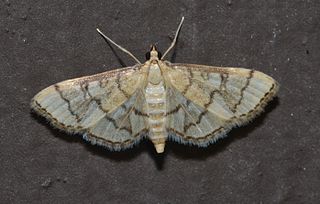| Blepharomastix guianalis | |
|---|---|
| Scientific classification | |
| Kingdom: | Animalia |
| Phylum: | Arthropoda |
| Class: | Insecta |
| Order: | Lepidoptera |
| Family: | Crambidae |
| Genus: | Blepharomastix |
| Species: | B. guianalis |
| Binomial name | |
| Blepharomastix guianalis (Schaus, 1924) | |
| Synonyms | |
| |
Blepharomastix guianalis is a moth in the family Crambidae. It was described by William Schaus in 1924. It is found in French Guiana. [1]

Moths comprise a group of insects related to butterflies, belonging to the order Lepidoptera. Most lepidopterans are moths, and there are thought to be approximately 160,000 species of moth, many of which have yet to be described. Most species of moth are nocturnal, but there are also crepuscular and diurnal species.

The Crambidae are the grass moth family of lepidopterans. They are variable in appearance, the nominal subfamily Crambinae taking up closely folded postures on grass stems where they are inconspicuous, while other subfamilies include brightly coloured and patterned insects which rest in wing-spread attitudes.
William Schaus was an American entomologist who became known for his major contribution to the knowledge and description of new species of the Neotropical Lepidoptera.
The wingspan is about 15 mm. The wings are white with lines of isabella colour. The forewing costa is suffused with light drab on the basal half. [2]

The wingspan of a bird or an airplane is the distance from one wingtip to the other wingtip. For example, the Boeing 777-200 has a wingspan of 60.93 metres, and a wandering albatross caught in 1965 had a wingspan of 3.63 metres, the official record for a living bird. The term wingspan, more technically extent, is also used for other winged animals such as pterosaurs, bats, insects, etc., and other fixed-wing aircraft such as ornithopters. In humans, the term wingspan also refers to the arm span, which is distance between the length from one end of an individual's arms to the other when raised parallel to the ground at shoulder height at a 90º angle. Former professional basketball player Manute Bol stands at 7 ft 7 in (2.31 m) and owns one of the largest wingspans at 8 ft 6 in (2.59 m).

Isabelline, also known as isabella, is a pale grey-yellow, pale fawn, pale cream-brown or parchment colour. It is primarily found in animal coat colouring, particularly plumage colour in birds and, in Europe, in horses. It also has historically been applied to fashion. The first known record of the word was in 1600 as "isabella colour"; this use later became interchangeable in literature with "isabelline" after the latter was introduced into print in 1859. The origin of the word is unclear; the uncertainty prompted by this has generated several attempts to provide an etymology and led to one prominent legend.


